Kelley School students are studying abroad in London over spring break, during a course called Topics in International Business: Brexit, Business and Brits.
Over 11 days, the students will explore London, learning about the basics of how business is conducted in the UK.
Students will also learn about the historic vote to leave the European Union in 2016, as well as the impact to business, government and the citizens of the UK.
Each day, a different group of students will send back their own account of the day.
Read along below as they recount their experiences in London:
By: Julie Pettypool and Ericka Coomer, BS’20
Excitement streams through us each morning as we prepare to hit the streets of London. Breakfast at the hotel helps to keep us full with all sorts of international delights such as a traditional English breakfast with poached eggs, toast, bacon and tomatoes.
After breakfast, we walked out into a rare London day … The sun was shining! Along with some rays, we took in some good London air as the group gathered to get instructions for the day.
A short walk down the street led us to our first double-decker bus, which took us to see the Queen’s Life Guard change. This means that we stood in a circle of gravel in an open space between government buildings in Whitehall and a pond across the street. We watched two different groups of elegantly dressed horsemen yell out instructions and excellently navigate their horses into formations.
Our transportation team then led us to 10 Downing Street, where we chatted with the gate guards and were tipped off that someone important was coming through sometime soon.
So, we waited and got to see the guards’ protocol of opening the gates. We may have been witness to the arrival of a diplomat in London.
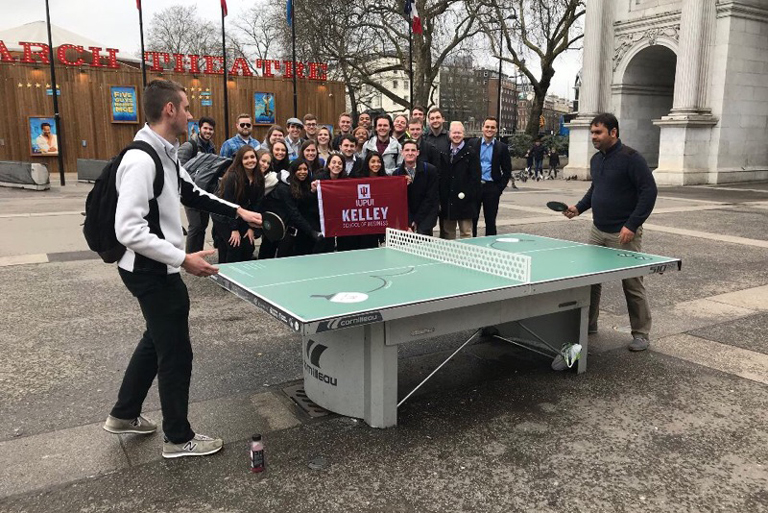
A brisk walk down some London streets led us to Marble Arch and Speaker’s Corner. We engaged with others standing around the area. A Kelley student quickly grabbed a paddle and started playing ping pong with a man at Marble Arch, and the game felt fun and relaxed.
Speaker’s Corner had a tense vibe to it due to a protest, and there were many police officers in neon green jackets keeping the peace. As we moved through the gates into Hyde Park, we encountered open spaces with speakers poised and ready to preach to anyone passing.
A Kelley student engaged with a speaker along with other members of the group, and we all got a good feeling of the goings on in the Speaker’s Corner.
The adventure didn’t stop there. We also got a spectacular tour of Tower Bridge, and we even got to see the Engine Rooms with their room-size, green-painted engines!
The tour gave us a good grasp at the scale of the brilliant ingenuity of the British.
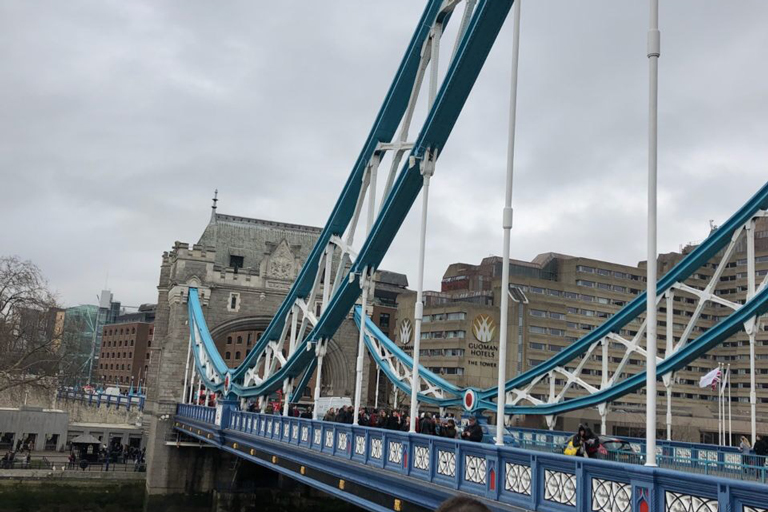
Our day as a group ended with a sighting of the Crown Jewels, which shimmered in splendid glory.
Their colors and designs impressed us, and we actually went back through the section of glass casings holding the crowns to get a second take.
The rain held off till the very end of the day.
We look forward to more exciting times ahead, as we continuously learn more about London’s history, culture and business world.
By: Abigail Gomez, BS’18; Maurice Reeves, BS’18
Greetings from across the Atlantic!
Today, the Kelley students in London had a wonderful day full of learning and sightseeing.
Our first destination was the original square mile of London that is now known as the Financial District. Many of the major companies that operate out of London are located here.
Thanks to the Insiders of London, we were able to see many of the city’s historic preserved buildings and its marvelous new skyscrapers. We learned that Londoners call this seeing “The Old & The New.”
On our tour we had the opportunity to see Lloyd’s of London, the Bank of England,
and even the first coffeehouse of London.
Did you know that coffee was originally brought to London by a Syrian slave? Before coffee became popular in England, the Brits enjoyed a pint of gin while trying to conduct business. Needless to say, after the advent of coffee they were much more productive.
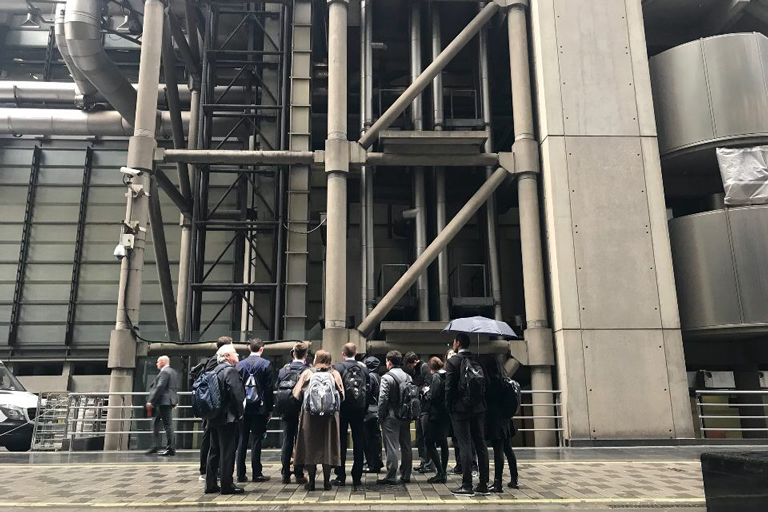
The design of Lloyd’s will leave you speechless and probably a little confused.
The building is like no other in the world of its feature of being inside out. The tubing and even the elevators of the insurance company can be seen from the street.
The architecture of the building is so unique that it is now listed as a historical attic fact although being built not too long ago compared to others around the city.
As we strolled to the Financial District, we came across the Bloomberg office in London.
For any student who has traveled here, I am sure you will understand the significance of actually seeing their award-winning office in the city of London.
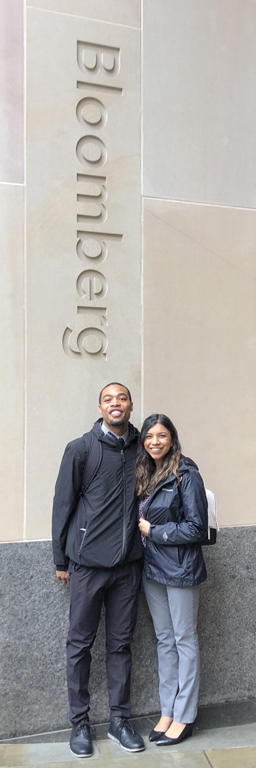
Although our walking tour came to an end, our day did not!
We ended our walking tour of the Square Mile at the London Stock Exchange. From the outside of the building, it would be incredibly hard guess what was inside.
This is because the London Stock Exchange is a bit more “humble,” as compared to our New York Stock Exchange that you may be familiar with.
Additionally, this exchange does NOT have a trading floor. They use an electronic platform to trade.
While at the London Stock Exchange, we received a private lecture from Paul Meadows.
Paul Meadows is Chartered Financial Analyst and teaches courses through Chadley House Training. He provided us with an in-depth look at how the equity capital financial markets work.
During our lecture we had a challenge to see who could guess the closing price of the FTSE100, which is an index of 100 largest companies on the London Stock Exchange by market capitalization. The winner was Parker Criswell, BS’19, who had the closest guess to its eventual closing price.
Today was the perfect balance of learning and tourism. We are super excited to see what tomorrow holds in store for us! Cheerio!
By: Meghan Ziegler, BS ’20, and Matt Sidor, BS ’18
The day began with a tour of the Silicon Roundabout in the East End of London. Formerly a shipping district, the East End has since been transformed over the past 15 years into London’s tech hub. We learned that these startup companies were originally attracted because of the low rent. The area has since been transformed, and even as our group was exiting the Tube, shops were scattered throughout the station showing the life and growth of the area. One of these shops was
Nincomsoup, which accepts Bitcoin as an acceptable form of payment and even has a Bitcoin ATM.
After meeting with our guide, we began our walking tour. Thankfully the rain held off, and we enjoyed a brisk London morning. We visited the
White Collar Factory, which is one of London’s emerging coworking offices. As well as startups, White Collar Factory also is the home to companies such as Adobe, Capital One, and Box.com.
With the growth of the district, the skyline is rapidly filling with modern apartments and offices. We walked through the streets lined with trendy stores and restaurants. This fast-paced and exciting area houses London’s most innovative companies, such as Google and Moo. Practically hidden within the modern buildings is Hoxton Square. This historic square has been the center of the community for hundreds of years and now connects those in the tech industry.
We ended the tour at the Google Campus. From there, we hurried across the river towards the U.S. Embassy. Opened in January of this year, the U.S. Embassy in London is the largest in Europe. The size makes it an imposing building in the surrounding skyline. We made our way through security and into the building. We were immediately faced by the massive Seal of the United States. The grandeur of the facility was as inescapable as it was breathtaking.
We were led to a conference room in one of the upper levels of the building. There we gathered around a panel of members of the economic, security, and public affairs outreach departments. We were given the opportunity to hear a little about their work, and they also fielded (perhaps more like volleyed) questions. Eventually, we had to let them get back to their work. We certainly walked away with far greater insight than we had come in with.
We then left the embassy to continue our journey. Our next mission was to explore some of the local culture. We returned to our side of the river to go to St Martin’s Theatre. There were a few hours between our departure from the embassy and the start of our show. Many of us took the opportunity to sample some of the local pubs (very important in British culture).
Afterwards, we arrived at the theatre and took our seats. We enjoyed a lovely performance of Agatha Christie’s
The Mouse Trap, which has been showing for 66 years. At the end of this thrilling performance, we were instructed not to reveal the outcome of the play in order to preserve the story for future audiences. We strongly recommend you visit St Martin’s Theatre to find out for yourselves who did it!
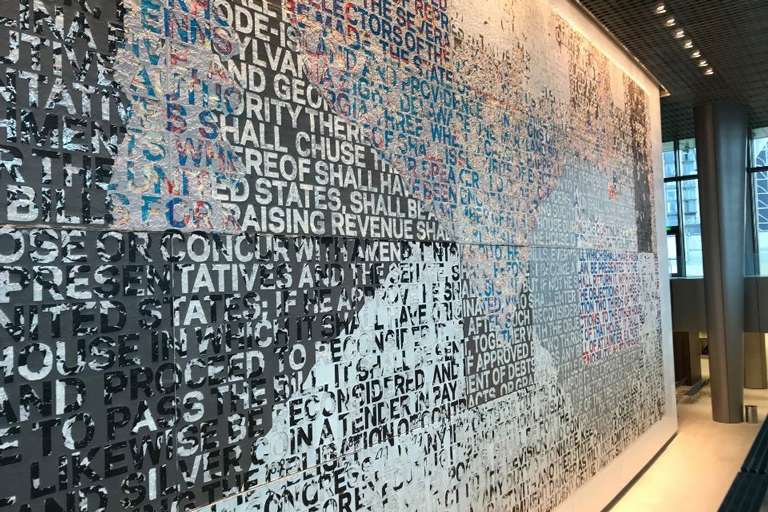
By: Luke Haskins, BS’18 and Nolan Enlow, BS’18
Greetings from London! Our day started out with our class heading back toward the Financial District.
We took a fascinating tour of the Lloyd’s of London, which is the oldest and largest insurance market in the world.
We passed through security, which we later learned on the tour was not because of the fear of security risks, but actually stems from the history of Lloyd’s original coffee shop location where Edward Lloyd wanted to deter people from coming in his shop and loitering.
First of all, the building was incredible.
It is built inside out so all of the utilities and services are on the outside, including the elevators (that made for an interesting ride).
As previously mentioned, the history of Lloyd’s began in 1686 in Edward’s Lloyd’s coffee shop, where maritime merchants and insurers would go, get a cup of coffee, and negotiate rates and terms for insurance. Edward Lloyd was smart and innovate enough to turn this into a business model and charge the two parties rent for conducting business in his shop, and thus Lloyd’s was born.
The business model operates similarly today, except with more parties involved providing more kinds of insurance with more complicated terms. The floor of Lloyd’s was one of the other most interesting parts of the building, which mirrors a very similar resemblance to the floor of the New York Stock Exchange. There are booths everywhere of brokers and underwriters, along with “traders” running around.
From Lloyd’s, the class split off into groups where some went to the Bank of England, some went back to the Tower of London, and some went back to Saint Paul’s Cathedral. This part of the day was a great opportunity for students to fully experience previous parts of the trip that we were either rushed on or too tired to appreciate the first time. This part of the day was also useful for relaxing a little bit, recharging our batteries, and just enjoying a little bit of free time.
After our adventures around London, we gathered together for a night of fine dining at
Simpson’s in the Strand.
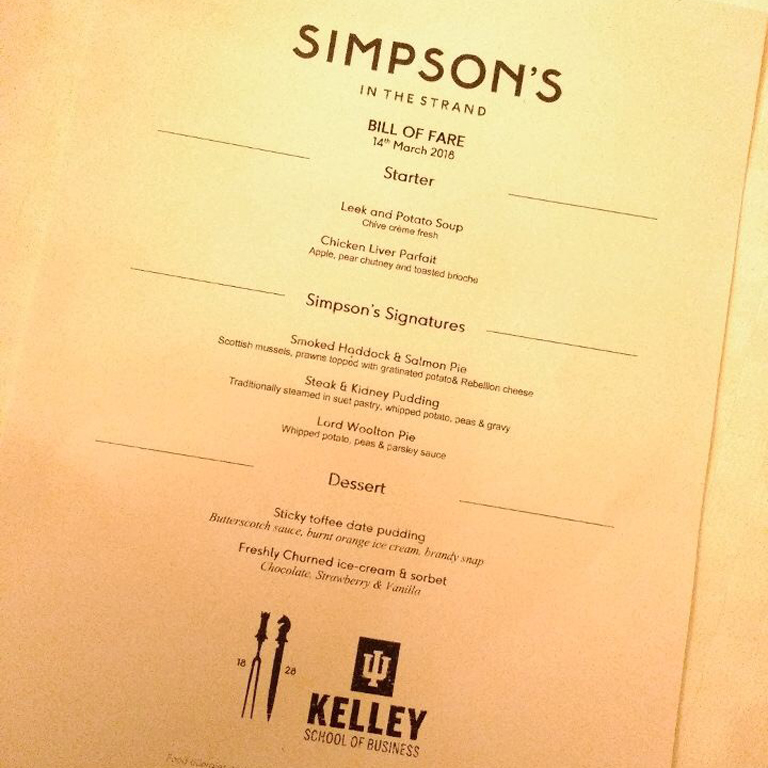
This historic restaurant, once frequented by Charles Dickens, George Bernard Shaw, and Winston Churchill, fed us a three course meal, with an entrée consisting of different types of vegetable and meat pies. What a fit for Pi Day!
Both before and after our meal, we were guided on a brief tour of different areas of Simpson’s. George Bernard Shaw, after finding refuge in the basement of the restaurant during the Blitz, signed his name on the kitchen wall, and his note has been immortalized in the basement of the building. Winston Churchill was a regular at Simpson’s, and he had a particular chair that he enjoyed while dining. One of the Kelley students had the honor of getting to sit in his seat as we ate, and many other students took the opportunity to take pictures in the seat after the meal was over.
With full stomachs, we walked back to the hotel, thankful for a sunny day, and in denial that this week is passing us so quickly! We look forward to tomorrow’s adventures.
By: Thatch Gbur, BS ‘20, and Kaleb Britton, BS ‘19
After spending several days making our way through London’s bustling cityscape, a day spent in a classroom felt welcoming and relaxing.
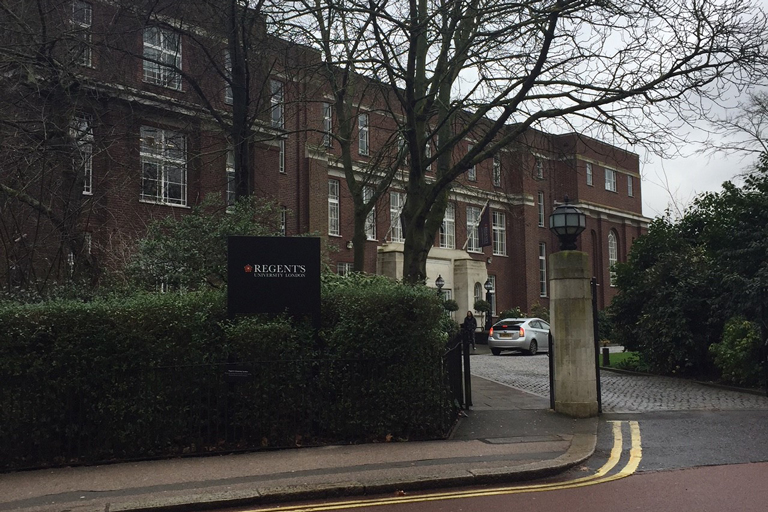
The classrooms of Regent’s University London have a much more subdued atmosphere than the tube stations adjacent to its campus. Regent’s University has strong American ties and offers UK and US degree programs.
The campus is represented very well internationally, with students hailing from over 140 different countries. Only twenty percent of the university’s students are British Nationals, with the rest of the university’s student body being international.
Kaleb and I vary greatly in our political opinions, but it was coincidental that we would be collaborating on this write-up after a day spent learning about the political implications of Brexit. Three professors from Regent University’s School of Business provided their differing viewpoints of Brexit during our day spent at Regent’s. Since Kaleb and I fall on opposite ends of the political spectrum, we decided to share our different opinions which were shaped by today’s lectures.
The United Kingdom and the United States share similar political environments currently. The US and the UK each experienced political shocks in 2016, with the Britons voting to leave the European Union, and the Americans electing Donald Trump as president. There are several similarities to each occurrence, both in what lead up to the events and the aftermath of them. Donald Trump and the Leave campaign both provided individuals who felt that they were being suppressed and silenced a platform for their voice to be heard. Hillary Clinton fared well in districts with large, urban populations, and had a commanding control of the millennial vote. Similarly, boroughs in the United Kingdom that housed major cities and many young people overwhelmingly voted to Remain.
The Leave campaign focused on access to goods, services, and capital, and the people that interact with those goods, services, and capital. The campaign stressed the importance of immigration policy reform. This connected well with individuals in rural communities who were heavily affected by the increased competition in the workforce stemming from increased immigration originating from non-EU countries.
The aftermath of Brexit is indeterminable until the leave occurs. The leave is scheduled to be finalized at 11 PM on March 29
th, 2019. The issue is not black and white, the United Kingdom can face varying degrees of change after the leave. Before March 29
th, 2019, however, the United Kingdom must find a way to address the 3,000,000 European nationals that reside in the United Kingdom currently. The United Kingdom must also deal with the phasing out of European Union laws as well as the restructuring of trade agreements.
It must be said that the choice of the UK to exit the European Union (EU) will come with some setbacks, though as was discussed today they may not be as impactful as initially thought. The choice made by the people of the UK to leave the EU was one which came from a socioeconomic divide caused by the mass immigration permitted by EU policy. The allowance of open labor mobilization allowed for immigrants from other European countries to mass migrate into rural communities. These immigrants were willing to work decreased wages which saturated the job market put many rural citizens out or work. While the EU policies worked well in heavily populated cities such as London, it was doing so at the expense of the livelihoods of local families in the name of globalization. The move toward independence from the EU allows the United Kingdom to control the amount of immigrant workers, negotiate trade deals which are unregulated by the EU, and have judicial independence. Leaving the European Union allows the UK many freedoms it lost from joining an alliance which is beginning to deteriorate.
Thatch and I may have two opposing views on Britain’s choice to leave the European Union, but they are derived from the in-depth lecture provided by the esteemed lecturers at Regent’s University London. The opportunity to be immersed in the current political issues going on in the UK has been a valuable lesson on both the impacts of globalism and how countries should respond to the changes caused by it.
By: Nolan Enlow, BS’18
The study abroad program to London was a once in a lifetime opportunity, and I learned so much on the way. Sure, some of the historical facts we can learn online or in a book, but there is no substitute for traveling to a foreign country to truly learn about its culture. During my stay in London, I was able to talk to students my age in pubs about their thoughts on Brexit, what their school system was like, and what it was like to live in the U.K. Being able to talk with the locals, eating English meals, traveling via the Tube, and listening to British lecturers about the political climate in the U.K. were just a few examples of cultural immersion I got to experience that week.
With regards to the itinerary, I really appreciated how varied the content of the week was. We were exposed to different kinds of education, while maximizing the time we had there. Having the opportunity to sit in a lecture in the London Stock Exchange gave us knowledge about what the business climate is like in London. Personally seeing Saint Paul’s Cathedral and Westminster Abbey exposed us to London’s history of Christianity, which is an extremely important aspect on how they got to where they are today with religion. Visiting Tech City gave us an idea on how much change London is going through right now and how much of the city is still growing. Being able to attend a lecture at Regent’s University gave us an idea about what the political landscape is like in the U.K. right now. Walking through Churchill War Rooms gave me a firm understanding of WWII history, which is integral in understanding modern Europe. The diverse format of sightseeing and education on the trip really provided for a well-rounded experience.
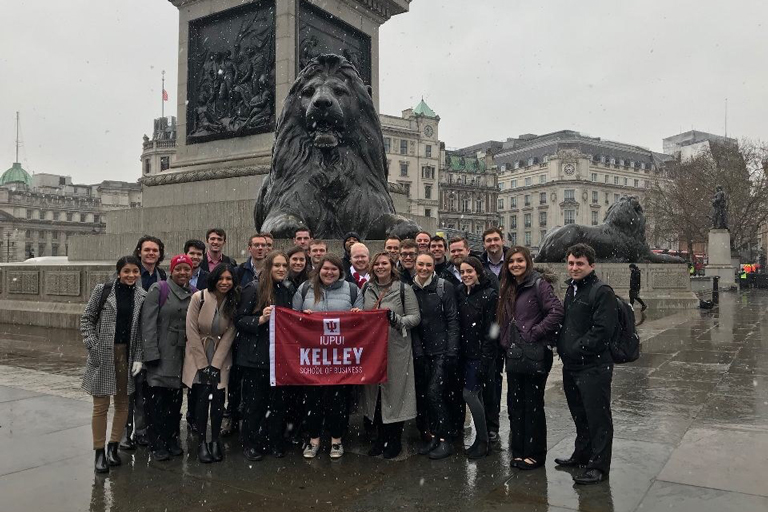
I strongly encourage students to study abroad, with any program, before they graduate. Globalization is here, and it is here to stay. American students should study abroad because gaining international experience and cross-cultural communication skills will put you ahead of your peers who do not possess those skills. These interpersonal skills you learn in such a short period of time are highly valued today in our interconnected global world. Studying abroad will also benefit students by forcing them out of their comfort zones. Learning how to live in a foreign country for a certain duration of time equips students with great problem-solving skills. President McRobbie has a goal of getting 75% of Indiana University’s students to study abroad before they graduate, and I think that will be a great initiative by IU.
This particular trip will benefit me greatly in my future professional career. London is known to be a financial powerhouse in the world, so understanding how business is done there will be an invaluable asset for me as Finance major. As I mentioned previously, the business workplace is now global, and if I want to climb the corporate ladder for a Fortune 500 corporation, I need to understand global issues and how they could affect a large multinational company. The global perspective I have gained from being enrolled in this program is a step in the right direction to achieve my goal of becoming a successful business executive one day.
By: Julia Pettypool, BS’20
Throughout my week in London, I felt a change stirring inside. Each day brought a new adventure and at least one new lesson. While in London, I came to realize that I have a lot to learn. What I experienced excites me to the core and drives me to keep feeding my intellectual curiosity. This trip opened my eyes to the varieties of thoughts, cultures, and environments that exist outside of the United States. Because of this class, including lectures at home and abroad, I now have a better understanding of the interconnectedness of our world and Brexit’s implications locally and internationally.
While in London, the class got to experience living like a Londoner by navigating the Tube and taking a double-decker bus. Pairs of us took on the challenge of mapping out our route each day, which aided us in our navigation of the city throughout the week. Timing is key, especially in business, and acquiring the ability to navigate a foreign transportation system will aid us in planning our routes and being on time throughout our future international business travels.
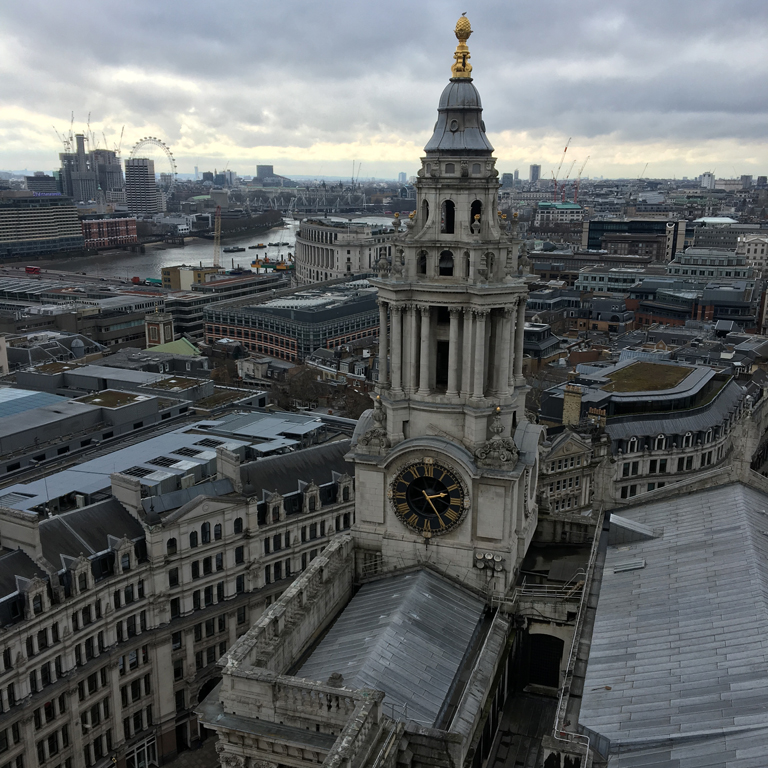
Looking back and picking out my favorite parts of the trip is difficult because I was grinning ear to ear the whole time. If I had to choose my most favorite experience, then I would say that climbing to the top of St. Paul’s Cathedral with our professor and another Kelley student would be number one. We climbed 528 steps inside the walls of the dome of the cathedral. While climbing, I got the sense of being in an Indiana Jones movie because of the stone walls and multiple levels of spiral staircases. At the end of our climb, we were rewarded with gorgeous views of the city and River Thames. I could have stayed up there all day.
Westminster Abbey also takes a top ranking among my most favorite places. Its grand design and historical artifacts fascinated me along with the Coronation Chair and colorful Cosmati Pavement. I could feel the power hanging in the air that was once held by the people buried in the various tombs positioned throughout the Abbey.
In addition to St. Paul’s and Westminster Abbey, my next favorite place would be the Palace of Westminster, AKA the Houses of Parliament. Our tour of Parliament ranks in my top three places we visited because of its history and the stunning level of detail in its design within each nook and cranny. We even got to see where Winston Churchill stood while delivering some of his famous speeches. Our tour ended with traditional afternoon tea in a room in the House of Commons overlooking the River Thames. How delightful!
Experiencing London and the impact of Brexit on the UK, EU, and US instead of just reading about it has brought a whole new meaning to topics in classes back home, such as micro and macroeconomics, political science, history, and business management. Moreover, physically and mentally being in a different country has helped to shape my new outlook on business and an international career. I now have a better idea of the numerous innovative business ideas out there and will be able to approach business problems and strategy with a more open-minded attitude, which will aid me in my business career moving forward.
Students who take this course will be able to better understand the nature of business because they will have experienced what it takes to conduct business in our interconnected world from a different perspective. Students will also grow themselves through their explorations of London and through the material presented in this course. I encourage anyone thinking about studying abroad and willing to learn to take this class.
If you want to live and learn history, go to London.
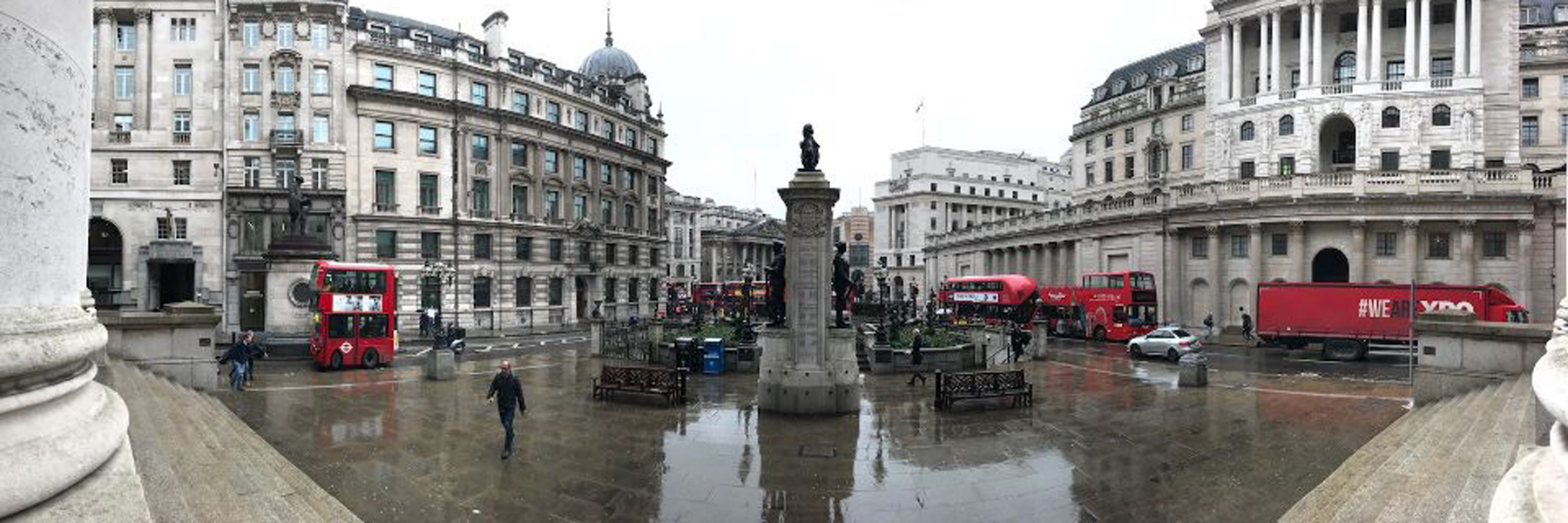
Leave a Reply